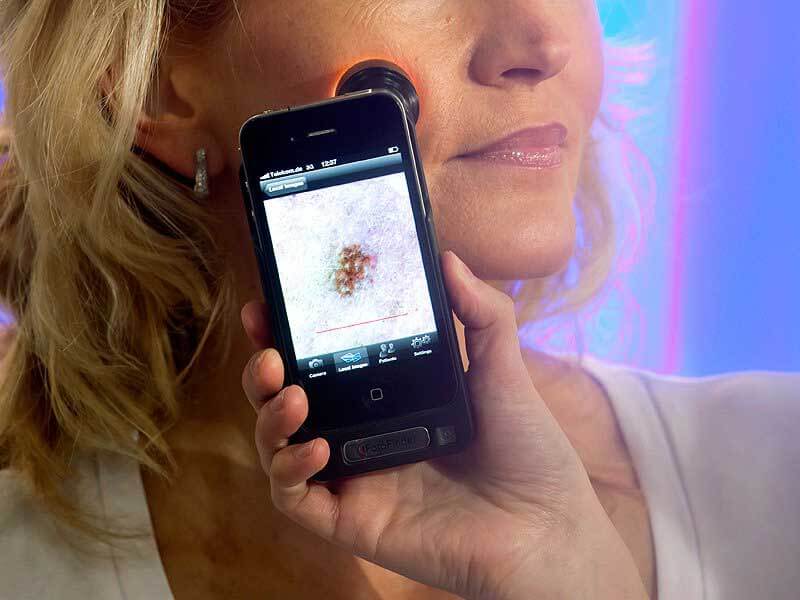- No more endless panic: teledermatology offers an immediate response
- Image recognition technology- the new skin cancer spy
- Nanoparticles: a secret weapon against cancer?
- New wearable sensors could prevent sunburn
Your skin can reveal a lot about your overall health, but serving as a mirror of your immune system isn’t its only role. Our skin is our biggest organ and our first line of defence. It protects us from a host of pathogens, but unfortunately it’s not invincible, and it can succumb to various diseases, such as skin cancer. According to the World Health Organisation (WHO), medical professionals globally diagnose “between 2 and 3 million non-melanoma skin cancers and 132,000 melanoma skin cancers” each year. Those are some alarming numbers.
Luckily, we can now access new technologies that promise more effective ways to diagnose and treat various skin conditions.
No more endless panic: teledermatology offers an immediate response
Nothing’s worse than spending hours in the waiting room worrying about a spot on your skin that has grown and changed colour. What if your biggest nightmare has turned into reality? What if it’s cancer? What if it’s already too late? A million ‘what ifs’ make each second creep past until the doctor can see you. In some instances you can end up waiting a very long time to see a dermatologist.
But thanks to a new model for dermatology consultations – teledermatology – this is changing. As our access to smartphones and file sharing increases, diagnosis is evolving. A recent study published in the Telemedicine and eHealth Journal shows that teledermatology could significantly reduce waiting times and drive down medical costs. Instead of waiting for an appointment, you simply upload photos of your skin problem to a healthcare portal, where medical professionals can offer their assistance. For instance, First Derm ensures a certified dermatologist will take a look, offer a diagnosis, and recommend a treatment. This way, you don’t have to wait ages to find out if your condition is alarming.

Image recognition technology- the new skin cancer spy
Most people have seen the effectiveness of image recognition tech. Facebook, for instance, is really good at recognising faces. But now, this tech is also finding major applications in dermatology, saving lives in the process. For instance, Stanford researchers taught a computer to diagnose moles and lesions with the same accuracy as a certified dermatologist. The first step included making a database of nearly 130,000 images of skin diseases. Then, they trained the algorithm to recognise potential cancer. Sebastian Thrun, the founder of the research and development lab Google X and a professor at Stanford University, said that their objective was to “bring the expertise of top-level dermatologists to places where the dermatologist is not available”. This could be a game-changer in skin cancer treatment, as early diagnosis ensures higher survival rates.
Nanoparticles: a secret weapon against cancer?
Nanotechnology is making waves in healthcare as well. In dermatology, nanoparticles are used to fight sun exposure and prevent premature skin aging. Now, researchers have begun testing nanomaterials for the treatment of skin cancer. Animal studies have shown that a nanoshell made from gold-infused nanomaterial can be effective in treating melanoma. Researchers at the MD Anderson Cancer Centre in Houston conducted a study in which these nanoshells were injected into mice with melanoma. The material readily accumulated in the cancerous tissues. When illuminated with a specific wavelength of light, the nanoshells heated up and burned the cancer cells, effectively killing them, while leaving the surrounding healthy tissues intact. This could be a revolution in melanoma treatment in humans.
New wearable sensors could prevent sunburn
The market for health sensors and wearables is soaring, and we can find all kinds of smart gadgets that diligently track our health, helping us prevent disease. For instance, L’Oreal, the cosmetics giant, introduced a stretchable skin sensor that measures sun exposure. It’s as ingenious as it is simple. The patch measures exposure to UV rays and photosensitive dyes in the patch detect changes in skin tone. Before the onset of sunburn, the wearable sensor changes colour, alerting the user to avoid direct sun exposure. Also, users can upload a picture of the patch to an app for analysis. It’s always better to be safe than sorry!

Dermatologists recognise the enormous potential of cutting-edge technologies. From diagnosis to treatment, these innovations are changing how we take care of our skin. Teledermatology ensures that we don’t have to wait an eternity for a diagnosis. Smart algorithms are providing the expertise of board-certified dermatologists, and nanoparticles might soon be saving lives. We’re excited to see what the future holds.
Share via:


